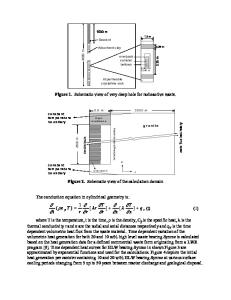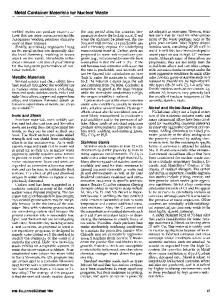Radiation Effects on Materials in the Near-Field of a Nuclear Waste Repository
- PDF / 835,999 Bytes
- 9 Pages / 612 x 792 pts (letter) Page_size
- 63 Downloads / 330 Views
Radiation Effects on Materials in the Near-Field of a Nuclear Waste Repository B.X. Gu, L.M. Wang, S.X. Wang and R.C. Ewing Department of Nuclear Engineering & Radiological Sciences, University of Michigan, Ann Arbor, MI 48109-2104, Email: [email protected] ABSTRACT The long-term radiation effects on materials in the near-field of a nuclear waste repository have been evaluated using accelerated laboratory experiments with energetic electron or ion beam irradiation. The materials studied include: zeolites, layered silicates (smectite clay and mica), as well as crystalline silicotitanate (CST) which is an important ion exchange material for the chemical separation of high-level liquid radioactive wastes. In situ transmission electron microscopy (TEM) during irradiation by energetic electrons and ions has shown that all of the studied materials are susceptible to irradiation-induced amorphization. At room temperature, complete amorphization was observed after ionizing doses of 1010 ~ 1012 Gy or displacement doses on the order of 0.1 dpa (equivalent to doses received in 400-1,000 years for a high-loading nuclear waste form). Amorphization may be preceded or accompanied by dehydration, layer spacing reduction and gas bubble formation. In the case of zeolites, CST and some layered silicates, radiation effects are significantly enhanced at higher temperatures. Our experiments have shown that amorphization or even partial amorphization will cause a dramatic reduction in ion exchange and sorption/desorption capacities for radionuclides, such as Cs and Sr. Because the near-field or chemical processing materials (e.g. zeolites or CST) will receive a substantial radiation dose after they have incorporated radionuclides, our results suggest that radiation effects may, in some cases, retard the release of sorbed or ion-exchanged radionuclides. INTRODUCTION Site restoration activities at US DOE facilities and the permanent disposal of nuclear waste generated at DOE facilities require working with and within various types and levels of radiation fields. Once the nuclear waste is incorporated into a final form, radioactive decay will decrease the radiation field over geologic time scale, but the alpha-decay dose for these solids will still reach values as high as 1018 alpha-decay events/g in periods as short as 1,000 years [1,2]. This dose is well within the range for which important chemical (e.g. increased leach rate) and physical (e.g. volume expansion or contraction) changes may occur in crystalline ceramics [3]. Release and sorption of long-lived actinides can also provide a radiation exposure to backfill materials, and changes in important retardation properties (e.g., cation exchange capacity) may occur. The objective of this research program has been to evaluate the long-term radiation effects in materials used in processing high-level nuclear waste or materials in the near-field of a nuclear waste repository. This is done using accelerated laboratory experiments utilizing energetic electrons and ions. The materials studied
Data Loading...











